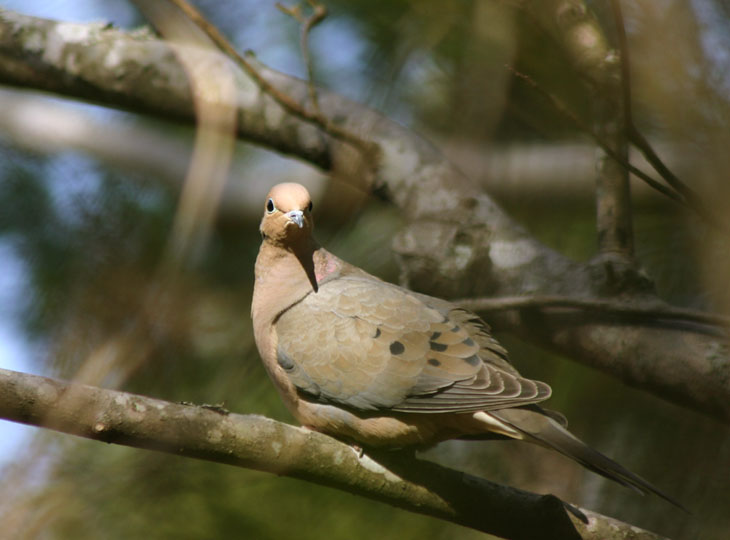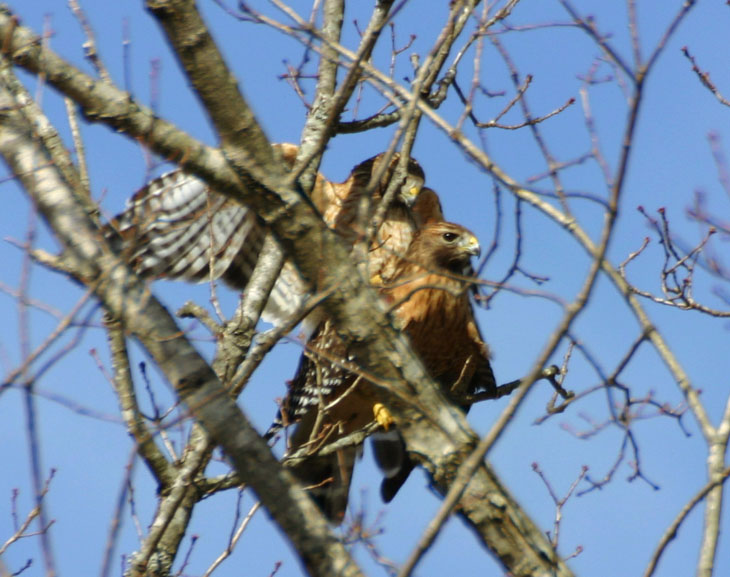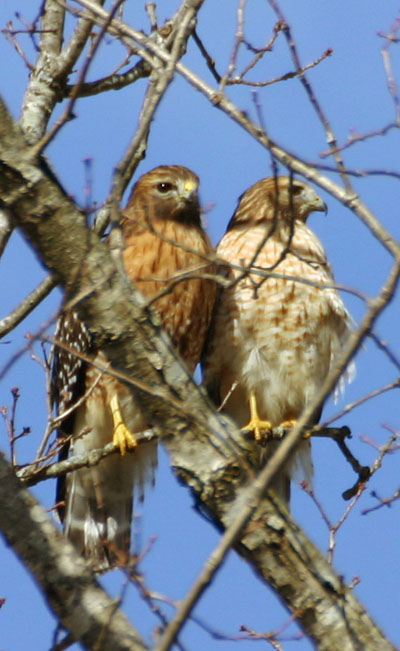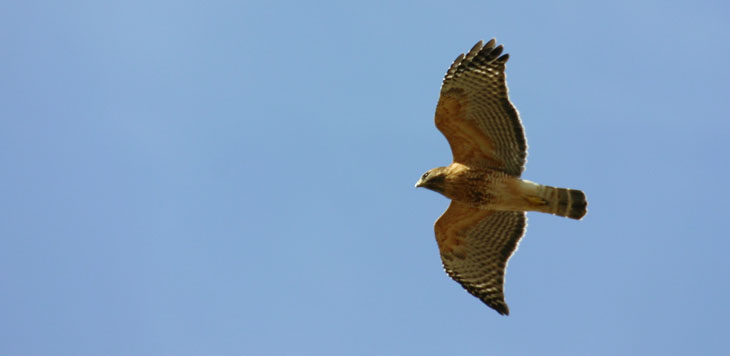
Yesterday I met a student at the local botanical garden and arrived early, so I did a quick tour. The NC Coastal section had been burned off recently, part of the biological maintenance which helps the new plants grow, but it meant there wasn’t much to see. However, a mourning dove (Zenaida macroura) flew up to a branch very close by, which started a slow stalking sequence as he went back and forth down to the ground and up to the fork of a tree – my part was attempting to follow this action with the camera.
 This pattern told me what was happening, confirmed after a shift in my position revealed the female in the fork, maintaining and rearranging the new nest as the male brought home materials. The location was excellent from their standpoint, but less so from this nature photographer’s, for exactly the same reason: it was extremely difficult to see. Hampered slightly by the garden trails I was requested to keep to, I had a difficult time getting any vantage that allowed a clear look past obscuring branches and foliage, but she obliged enough to sit up a little higher and appease the paparazzi, so I didn’t have to fetch a ladder or helicopter. Since she barely moved from position, I suspect she was either laying or already in possession of their eggs. For any birder seeking to spot nests, this is perhaps one of the easiest birds to choose, because their wings make a distinctive corduroy-like “wheep”ing sound that makes them effortless to follow. They’re also relatively slow fliers and fairly plump, which is why some people refer to them as “Accipiter Food” – accipiters being the birds-of-prey in North America that catch other birds on the wing. One could be blind and snag a mourning dove…
This pattern told me what was happening, confirmed after a shift in my position revealed the female in the fork, maintaining and rearranging the new nest as the male brought home materials. The location was excellent from their standpoint, but less so from this nature photographer’s, for exactly the same reason: it was extremely difficult to see. Hampered slightly by the garden trails I was requested to keep to, I had a difficult time getting any vantage that allowed a clear look past obscuring branches and foliage, but she obliged enough to sit up a little higher and appease the paparazzi, so I didn’t have to fetch a ladder or helicopter. Since she barely moved from position, I suspect she was either laying or already in possession of their eggs. For any birder seeking to spot nests, this is perhaps one of the easiest birds to choose, because their wings make a distinctive corduroy-like “wheep”ing sound that makes them effortless to follow. They’re also relatively slow fliers and fairly plump, which is why some people refer to them as “Accipiter Food” – accipiters being the birds-of-prey in North America that catch other birds on the wing. One could be blind and snag a mourning dove…
I mentioned earlier that the hawks were very active, and I’ve been watching them like, uh, a nature photographer to try and capture something interesting. Before I even left for the garden yesterday, The Girlfriend and I got lucky lucked out. The gusty winds have been very helpful to the buteos, the class of raptors most distinguished by their heavy bodies – flapping burns a lot of energy for them, but windy days mean they can soar with exceptionally little effort. Tracking the loud calls, a trio of red-shouldered hawks (Buteo lineatus) circled overhead at fairly good altitude, making it hard to get a detailed image, then abruptly descended, with a pair obtaining a perch in a not-too-distant tree with excellent light and pretty decent vantage. They waited patiently for me to get the 170-500mm lens locked onto the tripod before getting right to business.

Yes, I probably should have issued a warning for all the sensitive folk out there before slamming this picture up, but I suspect I’ve chased off any sensitive folk long ago anyway. This is indeed what they look like mating – don’t ask me if it’s typical for the female to look bored in a variety of species. A day earlier I had missed just this item of behavior, potentially from the same pair, due to much worse conditions and my inability to find them in the viewfinder fast enough (when the lens provides high magnification, just like with binoculars, seeing something with the naked eye and then finding it with a much narrower field of view can be difficult, and this was proof that I haven’t fully mastered that yet.)
 Afterward, they perched together, and I’d like to anthropomorphize even more and claim that this is the equivalent of small talk, but more likely, they were watching the nearby crows who had worked themselves into apoplexy (as crows are wont) because of the hawks’ proximity. This area is highly competitive, with songbirds, crows, and raptors all using it for nesting and food, and none of them liking the others nearby. The crows are the most obnoxious, often ganging up to harass other birds they consider a threat, but the raptors can usually hold their own. With the frequent displays of territorial and mating calls, from both the red-shouldered and red-tailed hawks, the crows have been maintaining a constant presence, only not too close – don’t piss off a hawk during Singles’ Night. About the only ones not appearing to react to others are the woodpeckers, who have been continually going about their business while all of this goes on, sometimes noisily, around them.
Afterward, they perched together, and I’d like to anthropomorphize even more and claim that this is the equivalent of small talk, but more likely, they were watching the nearby crows who had worked themselves into apoplexy (as crows are wont) because of the hawks’ proximity. This area is highly competitive, with songbirds, crows, and raptors all using it for nesting and food, and none of them liking the others nearby. The crows are the most obnoxious, often ganging up to harass other birds they consider a threat, but the raptors can usually hold their own. With the frequent displays of territorial and mating calls, from both the red-shouldered and red-tailed hawks, the crows have been maintaining a constant presence, only not too close – don’t piss off a hawk during Singles’ Night. About the only ones not appearing to react to others are the woodpeckers, who have been continually going about their business while all of this goes on, sometimes noisily, around them.
The male is on the right here. Typically, female raptors are bigger, but you may be able to see that the male is fluffed out a bit because, well, size does matter. In my experience, this is atypically pale for a red-shouldered hawk’s coloration, and he has fooled me before when wheeling overhead, because the light underside with speckling is a characteristic of red-tailed hawks (Buteo jamaicensis,) the other buteo that frequents the area; spotting a perched one earlier was what started the whole photo session.
The moment was brief, and both soon launched themselves into the air to circle overhead a few more times before drifting off, leaving me with little clue as to where the nest may be. I hope to spot this soon before the spring foliage makes such impossible, because it would be nice to follow the hatching and raising behavior, something I haven’t yet accomplished. We’ll see.




















































